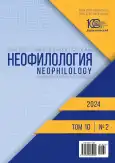The symbolic function of the portrait of Pope Innocent the X in F.M. Dostoevsky’s story “The Meek One”
- Authors: Iudakhin A.A.1
-
Affiliations:
- A.S. Griboyedov Moscow University
- Issue: Vol 10, No 2 (2024)
- Pages: 387-396
- Section: RUSSIAN LITERATURE AND LITERATURE OF PEOPLES OF RUSSIAN FEDERATION
- URL: https://journal-vniispk.ru/2587-6953/article/view/295601
- DOI: https://doi.org/10.20310/2587-6953-2024-10-2-387-396
- ID: 295601
Cite item
Full Text
Abstract
RELEVANCE. Pictorial discourse is an essential element of F.M. Dostoevsky’s artistic creativity, which performs a special symbolic function and provides additional semantic load. The purpose of the study is to analyze the symbolic content of the canvas by the Spanish artist D. Velasquez “Portrait of Pope Innocent the X” (1650) in the context of the author’s idea for the story by F.M. Dostoevsky “The Meek One” (1876).MATERIALS AND METHODS. The object of the study is the novel by F.M. Dostoevsky “The Meek One”, published in the November issue of the Writer’s Diary for 1876, as well as handwritten editions and rough sketches for the story. The methodological basis of the research includes the method of comparative historical and hermeneutical-interpretative analysis. The interdisciplinary nature of the research is due to the appeal to theological, philosophical, historical and art criticism issues.RESULT AND DISCUSSION. During the research, the presence of a symbolic correlation between the portrait of the pontiff and the image of the Pawnbroker was revealed. The motives of deception, despotic domination, fear and secret voluptuousness mutually intersect and complement each other, forming a double portrait of the pope and the hero of the story. For Dostoevsky himself, the image of Pontiff Innocent X could be a kind of personification of the Catholic institution of the Papacy and the tendencies hidden in it towards spiritual despotism and absolute domination over man. A vivid artistic device, which was never realized in the final version of the story, acquires special significance and sound in the context of Dostoevsky’s anti-Catholic polemic. CONCLUSION. The symbolic function of the papal portrait has an important conceptual significance, both within the author’s idea of the story “The Meek One” and beyond it in the context of Dostoevsky’s anti-Catholic discourse. The obtained conclusions make important adjustments to the further study of the story by F.M. Dostoevsky, deepening its semantic meaning.
About the authors
A. A. Iudakhin
A.S. Griboyedov Moscow University
Author for correspondence.
Email: Artemyudakhin@yandex.ru
ORCID iD: 0000-0003-4552-859X
Post-Graduate Student, Lecturer of History of Journalism and Literature Department
bldg, 35 Novaya Basmannaya St., Moscow, 105066, Russian FederationReferences
- Mekhtiev V.G., Lonshakova V.N. The author and the hero in “A gentle creature”. Mezhdunarodnyy nauchno-issledovatel’skiy zhurnal = International Research Journal, 2020, no. 6-3 (120), pp. 63-67. (In Russ.) https://doi.org/10.23670/IRJ.2022.120.6.077, https://elibrary.ru/gazrvd
- Shipitsyna N.V. Methods of forming a reader’s perception in the story “Mild natured” by Dostoyevsky. Vestnik Buryatskogo gosudarstvennogo universiteta = Bulletin of Buryat State University, 2014, no. 10-3, pp. 103-106. (In Russ.) https://elibrary.ru/tdumkf
- Oteva K.N. A Gesture of Despair in Dostoevsky’s Short story a gentle creature and its theatrical interpretations. Izvestiya Ural’skogo federal’nogo universiteta. Seriya 2: Gumanitarnye nauki = Izvestia. Ural Federal Univer-sity Journal. Series 2: Humanities and Arts, 2019, vol. 21, no. 4 (193), pp. 92-104. (In Russ.) https://doi.org/10.15826/izv2.2019.21.4.069, https://elibrary.ru/oryzvz
- Arya R. Painting the Pope: an analysis of Francis Bacon’s study after Velazquez’s Portrait of Innocent X. Literature and Theology, 2008, no. 23 (1), pp. 33-50. http://dx.doi.org/10.1093/litthe/frn039
- Saychenko V.V., Svitenko N.V. “…for our fathers had not admitted this”: civilizational choice of Russia in the modern age. Kul’turologicheskiy zhurnal [Journal of Cultural Studies], 2016, no. 3 (25), pp. 1-9. (In Russ.) https://elibrary.ru/zhnjdh
- Yudakhin A.A. Holbein’s dead Christ in F.M. Dostoevsky’s novel the idiot: Christological and anti-catholic dis-courses. Vestnik Moskovskogo universiteta. Seriya 9: Filologiya = Moscow University Philology Bulletin, 2023, no. 6, pp. 102-111. (In Russ.) https://doi.org/10.55959/MSU0130-0075-9-2023-47-06-9, https://elibrary.ru/sjblal
- Kamnev V.M., Kamneva L.S. F.M. Dostoevsky’s “Legend of the great Inquisitor” and Russian social changes historiosophy. Vestnik Leningradskogo gosudarstvennogo universiteta im. A.S. Pushkina = Pushkin Leningrad State University Journal, 2014, vol. 2, no. 2, pp. 51-64. (In Russ.) https://elibrary.ru/tdoebn
- Volkova E.A., Frolova E.V. F.M. Dostoevsky’s historical views on the Roman Catholic Church. Bulletin Social-Economic and Humanitarian Research, 2021, no. 11 (13), pp. 3-11. (In Russ.) https://doi.org/10.52270/26585561_2021_11_13_3, https://elibrary.ru/dfqqvs
- Yudakhin A.A. “Do you know, I have thought of giving up the world to the pope...”: the anti-catholic layer of the novel by F.M. Dostoevsky “Demons”. Neofilologiya = Neophilology, 2023, vol. 9, no. 3, pp. 573-582. (In Russ.) https://doi.org/10.20310/2587-6953-2023-9-3-573-582, https://elibrary.ru/wglzmu
Supplementary files











